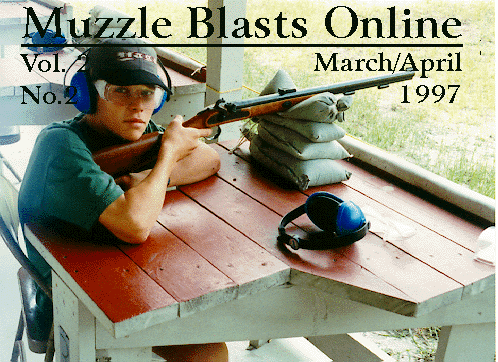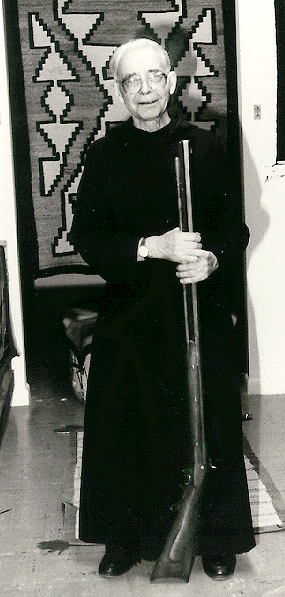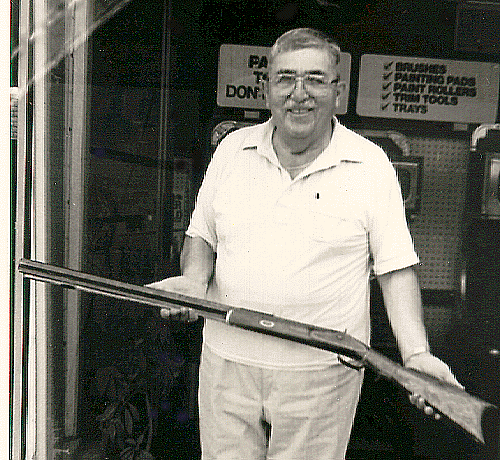|
Muzzle Blasts Online |
|
...for the muzzleloading enthusiast |
|
The muzzleblasts.com domain, subdomains, content, etc., are neither affiliated with the NMLRA nor its paper magazine Muzzle Blasts |
|
Muzzle Blasts Online |

|
|
|
|
|
|
My Hunt for the Tom Toben Rifle

|
|
Tom Toben with a long barreled Sam Hawken Rifle |
Because of my interest in locating Hawken rifles, made both in the Golden Age in the east and in St. Louis, from 1821 until the end of the muzzleloading rifle era, I started my search for the Toben Hawken rifle shown in his picture. The picture revealed that his rifle was definitely a Sam Hawken. It was made in the Hawken later years, from 1848 to 1854, after Jacob had died and before the design's demise in 1854 when Sam sold the Hawken Shop to his son William and Tristan Campbell. The Toben rifle had an exceptionally long barrel for a late Sam Hawken.
I kept looking for Toben's rifle over the years, and all I could find out was that no one had seen the rifle for a long time. John Barsotti, a National Muzzle Loading Rifle Association old timer, who had also been researching Hawken rifles for several years, had corresponded with some of the living relatives of Tom Toben, but none of them could shed any light on where the rifle was. When my Tom Toben article in Muzzle Blasts was published in June 1991, I concluded that maybe some day the Toben rifle might show up, but it didn't seem likely given the number of years it had been missing. Fortunately, this has not come to pass, and not just one Toben rifle has shown up, but I have found two.
When I made my yearly trip west in 1991, I stopped at the Fort Garland, Colorado Museum and met with the curator, Josephine Labato. I gave her a copy of my Toben story. While discussing it, she said that she knew where the Toben rifle was, and that the man who owned it lived in San Luis, Colorado, just 15 miles south of Fort Garland. Needless to say, this excited me considerably. Josephine called the owner of the rifle, a Mr. Charles Mondragon, Jr., and he invited me down to see it. His grandfather had been an old, close friend of Tom Toben, and was given the Toben rifle by Tom before he died in 1904. He brought out the gun, with documentation to show it had been Toben's, and called it a Hawken rifle. It had a heavy barrel and was an iron trimmed half stock Plains rifle. The barrel was stamped J. Birringer Leavenworth Kansas. It was a most interesting piece. It had been well used and was cracked at the wrist. It did not have any of the Hawken rifle features. On the rear of the barrel, there were 11 notches on the edge of the upper flat near the breach end. After examining the rifle, the question arose whether this was the rifle that Toben had used to kill the Espinosas?
When we got home from our trip, I started my hunt for J. Birringer. I couldn't find him in my books on riflemakers.
In those pioneer days, guns were essential items of every household, both for food and protection. It is listed that Birringer made fifty caliber rifles for hunters, immigrants, and scouts which are today listed as Plains and Mountain rifles. The J. Birringer Rifle that belonged to Tom Toben, and was given to Mr. Mondragon's grandfather, falls into that category. When and how Tom Toben got his J. Birringer Rifle is not known. It had plenty of use as you can see if you examine it. Birringer also made shotguns and pistols. His guns were not only used for hunting, but were shouldered by Kansas Militiamen, including Birringer himself, who marched out of Leavenworth with them during the Civil War.
Three of J. Birringer's sons learned the gunsmith and locksmith trade from their father, and Birringer Miller, a nephew of his son George, kept the business going until 1968 when it was sold to Cleo and Duane Wise. They still keep it going under the same name--``Birringer's Sporting Goods Store.'' The store celebrated its 125 years of business in 1964 and is still going.

|
|
Father William is pictured above holding the Toben Hawken. |
Specifications on both rifles are shown in the following table:
|
SPECIFICATIONS OF TOBEN RIFLES |
||
| Hawken Rifle | J. Berringer Rifle | |
| Total Length of Gun | 55in. | 49in. |
| Total Weight of Gun | 12 | 12 3/4 lbs. |
| Caliber of Bore | .54in. | .50in. |
| Length of Barrel | 38 3/4in. | 31 |
| Width Across Flats | 1 1/16in. | 1 3/16in. |
| Type of Breach | Hook | Hook |
| Type of Stock | Half Stock | Half Stock |
| Type of Trigger Guard | Late Hawken | Double Hook Kentucky |
Now that both of Tom Toben's Rifles have been located, and their history documented, it is still uncertain which rifle was used by Tom Toben to kill the Espinosas. There are notches on the barrels of both rifles. The Hawken was made first and the Birringer several years later, but we, at least, know that both rifles belonged to Tom Toben, and were used by him during his lifetime.
This concludes the story of ``My Hunt for the Toben Rifle.'' I would like to thank those who helped me get this story together. First are Tom Hart of Canon City, Colorado; Father William, curator of the Holy Cross Abbey Museum in Canon City, Colorado; Josephine Lobata, curator of the Fort Garland, Colorado Museum; Charles Mondragon, San Luis, Colorado; and Sandy Wise, Leavenworth, Kansas.
Bibliography
Kansas State Historical Society Mirror, Volume 31, No. 2, March 1985.
Leavenworth Times--May 3, 1959, June 16, 1980, May 13, 1984.
Museum of the Fur Trade--The Hawken Rifle Its Place in History.
